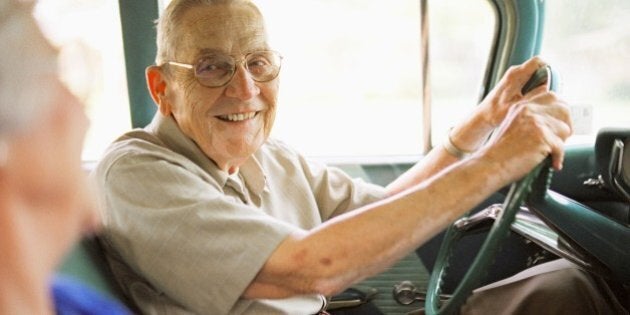
By: Stephanie Erickson
Are you concerned about a senior driving safely? Guest author and occupational therapist Susan Sofer (OT & CDRS) addresses this common concern for family members.
First, ask yourself these six questions:
- Does your friend or family member make any of these errors?
- wandering between lanes while driving
- incorrect positioning prior to a left turn
- wrong lane position after a turn
- hesitation to proceed at intersections, when appropriate
- inadequate checking of blind spots, and mirrors
- inadequate attention to road signs
- Are they aware that they are driving that way?
- Are you aware of your family member's driving habits? (speed, parking, territory...)
- Have you often heard your family member say "those young drivers are so impatient, always honking and speeding?"
- Have you considered why your family member's car is at the garage so often to for "touched ups" because someone "dinged" them in the shopping centre parking lot?
- Has someone you know been told that they were involved in a "Hit and Run" and have to have a driving road test?
If you answered yes to any of the above questions, the following information will be of interest to you.
Is there an age limit for driving?
What society views as the "Older Driver Problem" is really a "Medical Condition and Driving Problem".
As a driver, our skills needed for driving peak when we are a young adult. It is the years of driving experience and our skills that help us to drive safely. Yet as we grow older, the skills needed for safe driving may change due to a medical condition (1 or more) we have and the prescribed medication(s) we take. Our driving experience is what allows us to continue driving safely and compensate for any gradual changes in our skills.
Drivers who are aware of gradual changes in skills will typically self-regulate his/her driving by:
Limiting when they go: driving twilight or night time/ rush hour/ dense traffic areas
where they drive to: familiar versus unfamiliar routes/downtown versus rural
how much driving they do: neighborhood/short distance/ highway driving
Driving is a skill.
As an occupational therapist, certified in driver rehabilitation, I consult, assess and retrain people with respect to their driving abilities and am asked to determine whether the person is safe to continue driving. Years of observing and assessing people's driving performance has allowed me the opportunity to notice common errors committed by many experienced drivers.
Driving is an activity of daily living (ADL) just like getting washed, dressed or cooking. It is an activity that we learn to do once the skills needed to drive have matured.
In order to drive safely, we rely on the fine-tuned integration of the necessary physical, visual, cognitive-perceptual, and behavioural skills. Just to name a few, these skills include:
- coordination and reaction time
- visual scanning and speed of processing visual information
- divide attention, concentration
- speed of analysis and decision making, and
- judgement.
- How do you know if a driver is still safe to keep driving?
10 warning-signs of unsafe driving include:
- Unaware of driving errors
- Driving too slowly
- Being honked at by others
- Close calls
- Unaware of other vehicles
- No observation on merge, yield or uncontrolled intersections
- "Wandering" between lanes
- Missing traffic signs/Failing to stop at stop sign or red light/Stopping at a green light
- Getting lost or confused
- Confusing the brake and gas pedals
An assessment of a person's driving ability should be done if there is:
- a decline in ability to do everyday tasks
- memory loss
- poor judgment
- indecisiveness
- disorientation
- loss of strength, flexibility or balance
You are concerned, but how do you proceed? How do you get your family member to agree to a see an occupational therapist?
You or someone you know who has driven with the "driver in question" can complete an on-line questionnaire that will provide guidance as to the type of recommended intervention/ assessment. Go to this website, complete the "Fitness to Drive Screen" questionnaire on your own, without the input of the driver.
If need be, the completed questionnaire can be forwarded to me for further discussion.
Explain to the driver your concern for their health and safety; that you would like them to continue driving and maintain their independence but that you would feel more at ease if a professional who works in the area of driving tested them and confirmed their road safety.Much like when they don't feel well and they go to the doctor; he sends them for blood tests or x rays to rule out any medical conditions and then decides if any treatment is necessary.
You can accompany your family member to their annual medical appointment with their family doctor or geriatrician and ask the doctor "Is it ok for my dad/mom to continue driving?"To avoid asking this question in the doctor's office, you can call the office ahead of time, asked to speak to the doctor or leave a message that you would like him/her to discuss the subject of driving and suggest a driving assessment.
The assessment should be done subsequent to consulting with an experienced occupational therapist that is certified in driver rehabilitation. The reason for this is to determine: why someone with years of experience is making errors? Which skills have deteriorated? And can these skills be improved?
Options at this point could be:
- Consultation - to discuss a particular situation and how to proceed
- Screening - to obtain limited objective information to better advise driver/family of risk level and how to proceed, or
- Assessment - that includes an in-office interview and assessment of physical, perceptual-cognitive skills, as well as an on-road test.
- Keep in mind that someone may also have difficulty performing safe driving manoeuvers due to physical changes to their neck, arms and/or legs. This is also looked at during the assessment. The addition of adapted equipment to the car may allow the driver to compensate for any physical changes and allow them to drive safer. Road lessons are necessary to teach the driver to safely use the equipment.
Please call if you have questions or require more details about the above information. Other transportation-related services include requests for handicap parking stickers, and Adapted Transportation.
Susan Sofer, OT & CDRS, Director of ACT Inc
Experienced Occupational therapist, Certified in Driver Rehabilitation
514-733-1414
Stephanie hosts her own weekly podcast called Caregivers' Circle on http://www.webtalkradio.net. She also founded Erickson Resource Group which offers holistic services to seniors and their families: http://www.ericksonresource.com
This story was published on Alzlive.com, a website for caregivers of people with Alzheimer's and dementia. For more tips and support, visit the site here.
ALSO ON HUFFPOST:
